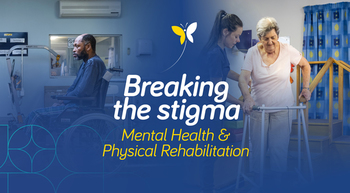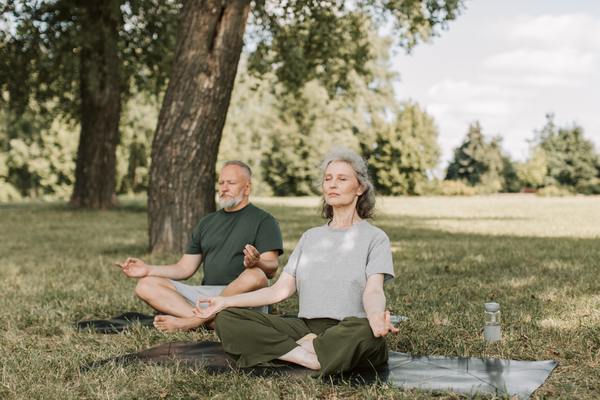
Breathing and Grounding
by Louise Heunis
Occupational Therapist and Advanced Breathwork Facilitator
“Some doors only open from the inside. Breathing is the most direct way to accessing that door.” When you own your breath, no one can steal your peace.
In this challenging time, many of us are struggling with feelings of uncertainty, anxiety and overwhelm. Our lives have been turned upside down to say the very least. We’re having to adapt to new routines, a lack of free movement, severed social interaction and in many cases a lot of time on our hands. Some are experiencing more serious circumstances in the home, like addictive patterns of our self or a partner, abuse or financial troubles. These changes to our daily life, may have left many feeling disempowered, depressed, afraid.
Caged-animal syndrome might be an apt diagnosis
In this article, I would like to introduce you to a powerful tool that you have to your disposal anytime, anywhere, at no cost. It requires no prescription. In fact, all it requires is a little bit of your time each day, and a few minutes whenever you feel a sense of overwhelm.
That powerful tool is called the BREATH. If I told you that you can survive on average, without food for 3 weeks, without water for 3 days, but without air only 3 minutes at most? You would begin to understand the power and importance of the breath.
We breathe around 23 000 breaths per day. Make each one count
Our breathing is the only part of the autonomic nervous system we can consciously control. Each emotional or mental state has a corresponding breathing pattern. It follows that by using conscious controlled breathing, we can change our emotional or mental state within minutes. Whatever, you need in the moment, your breathing can provide.
Breathing – a Powerful tool
There are hundreds of different breathing techniques, many with sound scientific research behind their effectiveness.
Learning how to utilize the breath, according to what you need in the moment, is essential. The following is a guide to choosing the appropriate breathing technique to help you regulate your system.
These are 3 of my favorite techniques, that I personally practice on a daily basis as part of my own breathing practice, and that I teach to my patients here at Nurture Woodlands Recovery Unit.
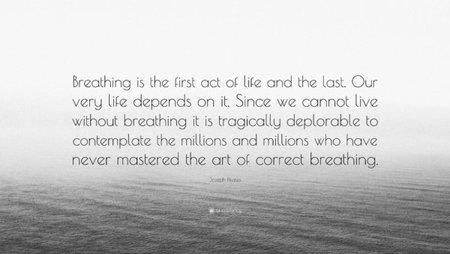
Fire Breaths for Energy (a shot of espresso to the system)
When to use: If you lack energy and feel tired or drained. When you need a pick-me-up.
Effect: Creating a charge of energy in the body. It’s natural to feel a buzz of energy, alertness and clear thinking after the exercise. If you feel giddy or lightheaded after the exercise, slow your pace down next time.
For best results: practice 1x daily or as needed.
Time required: 2-3 minutes
Benefits:
- Helps to strengthen and regulate the nervous system and move out of negatively spiraling emotional states such as anxiety.
- Helps to detox and to release toxins and waste products from the respiratory system. Energising the body and mind.
- Assists to overcome cravings for addictive substances, such as smoking or harmful habits such as gambling.
- Provides relief from chronic pain and severe tension.
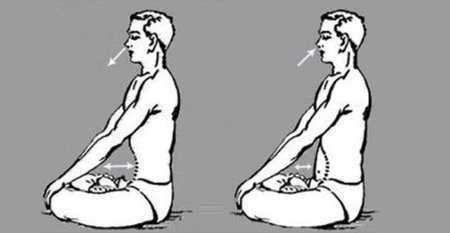
METHOD FOR BREATH OF FIRE
VIDEO TUTORIAL: How to do Breath of Fire Tutorial (3.16 min)
Video by Brett Larkin Yoga
Step 1: Sit in a chair or on the floor. Straight back. Focus on the exhale. As you exhale pull the belly button closer to the spine. The inhale is passive and quiet. The exhale is loud and powerful (snap it loose). Begin the practice exhaling through the mouth and inhaling through the nose (panting like a dog). Find a steady pace.
Step 2: Once you get the hang of it, close your mouth and start to breathe through the nose. Then quicken your breathing to 1-2 breaths per second. Once you master this pace, you can increase the pace to 2-3 breaths per second. Form is more important than pace, so don’t go too fast.
If it’s a workout for your belly and abs, you’re doing it right.
Step 3: Repeat 20 cycles (inhales and exhales)
Step 4: Return to natural breathing for 5 to 10 cycles (inhales and exhales)
Step 5: Repeat step 3 and 4 another 2 times. A total of 3 minutes
Step 6: Return to natural flow
Once you’ve finished, meditate on the breath. Let your breath rest in its natural flow. You can lie down on your back and follow your inhales and exhales for 5 minutes. Try to let go of thoughts. Return your focus to the breath time and again.
Contraindications:
People with cardiac problems, spinal disorders, respiratory infections or pregnant women should not do this breath.
4-7-8-Relaxation technique (similar effect to taking a few drops of Rescue remedy)
When to use: If you feel physically tired, are struggling to sleep or emotionally unsettled.
Effect: Creating a powerful relaxation or tranquilizing effect on the system. Deactivates the fight or flight response. It’s natural to feel very calm after the exercise. Slows heart rate, blood pressure and digestion. Increases blood circulation (cold extremities and restless leg syndrome).
For best results: practice 2x daily for 6 weeks. Never more than 4 breaths at a time. After 1 month of practicing increase to 8 breaths at a time maximum.
Time required: 2-3 minutes
Benefits:
- Helps to calm the nervous system through switching on the rest and digest (parasympathetic) system.
- Helps with insomnia. Provides relief from chronic pain and severe tension.
- Assists to overcome cravings for addictive substances, such as smoking or harmful habits such as gambling.

METHOD FOR 478 BREATHING
VIDEO TUTORIAL: How to perform the 478 breathing exercise (5.37 min)
Video by Dr Andrew Weil, MD
Step 1: Lie down or sit up. Exhale fully through the mouth
Step 2: Put your tongue on the soft tissue behind your upper front teeth
Step 3: Inhale through the nose for a count of 7 (quiet inhales)
Step 4: Exhale through the mouth for a count of 8, making a whooshing sound as you breathe out
Step 5: Repeat 4 cycles
Step 6: Return to natural flow of breath
Contraindications:
Don’t do when driving or when full focus and attention is required since it can have a powerful tranquilising effect.
5-5 or Coherent breathing for Balance (similar effect to drinking water- can do anywhere and anytime to find harmony
When to use: From feeling stressed and anxious to struggling with insomnia and lack of concentration. Anywhere and anytime. Technique to slow down and deepen the breath to 5 breaths per minute.
Effect: Calming and grounding yet alert and focused. Feeling balanced and stable.
Benefits:
- Balancing the stress (sympathetic) and relaxation (parasympathetic) responses of the body. Very powerful effect to increase HRV (heart rate variability) which is a direct measure of balance between the stress and relaxation responses in the body. Activates the vagus nerve which in terms activates the rest and digest or relaxation (parasympathetic) system.
- Balance between left and right hemispheres which results in feeling grounded and calm. Helps with insomnia.
- Increases focus, learning or problemsolving skills.
- Improves metabolism and nutritional uptake.
For best results: practice once or twice daily for 5minutes, building up to 20 minutes at a time.
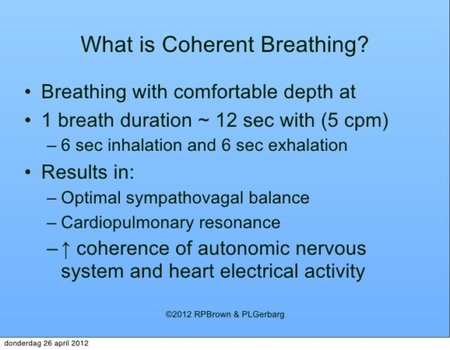
Time required: 3-5 minutes
Autonomic balance = 5 breaths per minute (as seen in this diagram)
METHOD
VIDEO TUTORIAL: Coherent breathing meditation 10 second cycle with bells (33mins)
Outer Space to Inner Space
Step 1: Lie down or sit up. Place hands over the belly to ensure that the belly expands as you breath in. Follow the breath as it comes in and out for a minute or so.
Step 2: Inhale through the nose for a count of 4. Exhale through the nose or mouth for a count of 4. Repeat for 1 minute
Step 3: Inhale through the nose for a count of 5. Exhale through the nose or mouth for a count of 5. Repeat for 1 minute
Step 4: Inhale through the nose for a count of 6. Exhale through the nose or mouth for a count of 6. Repeat for 1 minute
Step 5: Return to natural flow of breath
Increase the length of the practice by a minute or so per day, building up to 20 minutes.
Contraindications:
None- this is a ‘water technique’. You can do it throughout the day, anywhere and anytime you require.
I hope you find these techniques inspirational and life-changing.
HAPPY BREATHING!





